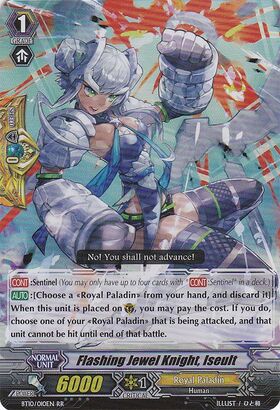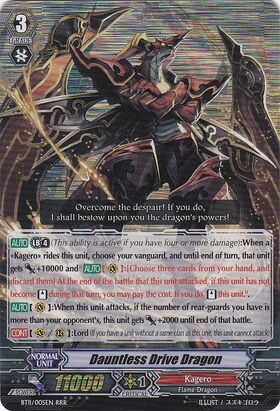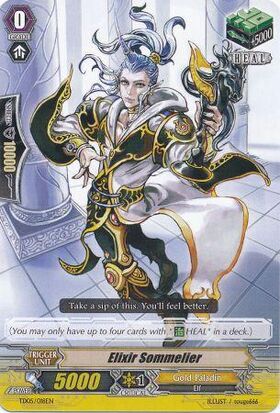Misconception: "I won't guard until I'm at 5 damage"
On the surface, it seems like a rational idea. If you don't guard until you have to, then you'll have more cards in hand to guard with. However, when you start applying some of the other strategies I'll discuss, you start seeing the holes in this plan. You could compare it to last minute Christmas shopping: you don't have the convenience of looking around for the cheapest price. Likewise, you lose the leniency of being able to choose to take a damage, and are forced to guard every attack that your opponent throws at you. Did they sack a double trigger and throw it on a Palamedes? Bet you wish you didn't have to guard it.
That's right, you do hit Limit Break early, obscenely early. What does that accomplish, though? Say, for instance, your Vanguard is Dauntless Drive Dragon and, since you got to Limit Break so early, you Broke Rode. Your opponent, who is utilizing early guarding, is sitting on 2 damage. What incentive do they have to guard your Vanguard? Even if you get a crit, they can guard the second attack and be sitting safely on 4 damage, whereas you just wasted your Break Ride, your win condition, and suffered the net -1 that Dauntless is. What's more, now they have access to Limit Break, and you're sitting in a position where surviving a similar push looks to be very difficult. Or perhaps your Vanguard is King of Masks, Dantarian, and you're in the same situation: You decided not to guard early, and the damage is your 5 to your opponent's 2. You break ride Dantarian, giving the Break Ride's skill to your 2 Rear Column boosters and 1 Rear Guard. Your opponent, at such a low damage, isn't inclined to guard your attacks and end their turn at 5 damage and no fewer cards in hand than when they started, or at even less damage if they decided to guard an attack, and proceed to use their own Limit Break the following turn, which you're forced to guard against.
Early Guarding
To avoid the above situations, lets rewind the game to the very beginning. Your opponent attempts to get a little aggressive early on and calls an unboosted Rear Guard to attack you while on Grade 1 or 2. You look at your hand and see you opened with a draw trigger. Do you guard this attack, or do you take the damage? The correct answer is guard. What else are you going to do with that draw trigger?
The key is to remember that 1 damage is always 1 damage, no matter when in the game you take it. The basic idea behind early guarding is that, the earlier in the game you guard, the cheaper it is. Take the above example, where you blocked 1 damage for only 5,000 Shield. Had you taken that damage, later in the game, you would be at 5 damage instead of 4, and your opponent would be attacking your Vanguard with a 16,000 Power attack, or even 21,000. If you had decided to guard the earlier attack, you would be free to take this damage and save what would otherwise be 15,000 Shield, whereas had you taken the damage in the first scenario, you would be forced to block this attack for 15,000 Shield. Essentially, you would have decided to use 15,000 Shield out of your hand instead of 5,000.
The basic idea behind the game is to get the opponent to 6 damage, thus winning. With the guarding mechanic, giving the opponent the ability to prevent themselves from taking that 6th damage, the game then becomes a race to see who can deplete the others' shield value the fastest. Compare the two situations above: Guarding the first attack would leave you with 10,000 more shield than if you decided to take the first attack and guard the later one. Its decisions like these that make or break a player, as an extra 10,000 shield in the late game can easily spell victory or defeat.
Perfect Guards
 Another dilemma players face is when they should use Perfect Guards. As you are only allowed to use 4 of these in a deck, and are likely to damage check/ride one, and there is no guarantee you'll even see all of them in a game, they should be considered a very scarce resource, and misusing even one could be detrimental.
Another dilemma players face is when they should use Perfect Guards. As you are only allowed to use 4 of these in a deck, and are likely to damage check/ride one, and there is no guarantee you'll even see all of them in a game, they should be considered a very scarce resource, and misusing even one could be detrimental.
First, what should a Perfect Guard be used for? It uses 2 cards out of your hand to guard 1 attack, which is no different than an attack that requires 15,000 or 20,000 Shield to block. Since guarding is all about efficiency, then anything that would require 3 or more cards from your hand to block is a valid attack to be Perfect Guarded. However, in order to truly know the best time to use a Perfect Guard, you have to know the opponent's deck.
For example, assume the opponent is playing Sealed Dragons, and their current Vanguard is Sealed Dragon Blockade. You are at 4 damage, meaning you are in danger of losing if they Drive Check a critical trigger, so you correctly decide to block this attack. Should you use a Perfect Guard here? No! You know the opponent is running Sealed Dragons, so you know that eventually they will ride into Blockade Inferno, who has a Limit Break that increases his power by 10,000. Knowing this about the deck, do you think you should use your Perfect Guard on the 17,000 Power attack that you are facing now, or save it for the 28,000 Power attack that is sure to come within a turn or two?
Fielding Your Shield: Grade 2's Vs. Grade 3's
Imagine it: You have a near-full field, with only one front row Rear Guard circle open, and a hand composed of a good amount of shield value, Grade 2's, and a Grade 3 or two. For the sake of the scenario, the booster behind the empty RG slot is 7,000 Power, all of your Grade 2's in hand are 9,000 Power, and your opponent's Vanguard is at 11,000 Power. Assuming that you will force the same amount of guard if you called a Grade 2 or 3, which do you call? The answer you might be thinking is "I'll call the Grade 3, because it doesn't have shield value," but that is wrong, and for that exact reason. The only way Grade 3's can have shield value (outside of random skills like Mandala Lord), is when they're used as the discard cost when using a Perfect Guard. Meanwhile, Grade 2's can function as intercept units and a 5,000 shield in your hand. If your goal is to maximize the amount of shield you have, the correct answer is obvious.
Obviously there are exceptions to this. Your opponent may have an unboosted Grade 2 unit with 9,000 Power that can't hit your Vanguard, or anything else on your field, but would be able to hit a Grade 2 you decided to play. This would call for you to play your Grade 3, to prevent their unit from being able to hunt your Rear Guards. You would also play your Grade 3 instead of your Grade 2 if it would create a stronger powerline (i.e. you have a 7,000 Power booster but their Vanguard has 13,000 Power). There is never one thing you should always do, and being able to recognize these situations and make the most optimal plays are what define good players.
Obviously there are exceptions to this. Your opponent may have an unboosted Grade 2 unit with 9,000 Power that can't hit your Vanguard, or anything else on your field, but would be able to hit a Grade 2 you decided to play. This would call for you to play your Grade 3, to prevent their unit from being able to hunt your Rear Guards. You would also play your Grade 3 instead of your Grade 2 if it would create a stronger powerline (i.e. you have a 7,000 Power booster but their Vanguard has 13,000 Power). There is never one thing you should always do, and being able to recognize these situations and make the most optimal plays are what define good players.
Hoping for Triggers
Your opponent has just attacked with their Vanguard, resulting in one trigger on their Twin Drive, which they gave to one of their Rear Guards. Their two remaining Rear Guard columns are 16,000 and 21,000, thanks to the trigger. You have the ability to take damage from one of them, and for the sake of this scenario, you will take damage from one of them. Which one? Assuming your Vanguard is 11,000 Power, do you block the 16,000 Power attack and take the damage from the 21,000 Power, or do you take the 16,000 Power attack and hope to get a damage trigger to lessen the amount of shield needed to guard the 21,000 Power attack? Let's look at shield value:
The 21,000 Power attack takes 15,000 shield to guard. If you get a damage trigger, it will take 10,000 shield to guard.
Essentially, you are debating on choosing to expend 10,000 shield, or choosing to expend 15,000 shield to MAYBE have to spend 10,000 shield. The answer is, again, obvious. However, in the middle of a cardfight, there are plenty of players who neglect to think about these kinds of things, and they fail to recognize them as game-losing plays.
Going into every game, your opponent's goal is to deplete your guard and widen the gap between the amount of shield they have and the amount you have. Each time you guard incorrectly or inefficiently, you're only helping them achieve that. You may think 5,000 shield isn't much, and over-thinking something as "small" as that is meaningless, but those instances add up. Look back at all of the examples I laid out in this article alone, and compare the correct outcome and the incorrect one. That would add up to a good 15,000-20,000 shield over the course of the game. That's a 2-pass to their Vanguard, or the ability to block that last Rear Guard column they threw two triggers on when they sacked a double trigger Drive Check.


No comments:
Post a Comment